Barrenjoey High School Inaugural Students: 1968 To 1973
50 year celebration of Inaugural graduating class
Members, and some attending former teachers, state the group is 'a family' and shared memories of surfing at lunchtime, how tall the Avalon Beach sand dunes once were, and the horse paddock for those who would ride to school - and that awful and soon discarded 1st year red beret.
Barrenjoey High School during he years of the school's inaugural class
The students state they had great teachers- many recall these were only a few years older than them when they first began.
A few memories shared:
Sarah-Lulu, who rode her horse to school recalls ’ We had races along the beach. There was six of us who rode to school then.'
Sarah-Lulu: this was a brand-new school – they had in new ‘donuts’ as the next form was coming through, just before they started. They were still building when we started.
What is the best part of you of being in that inaugural class?
Sarah-Lulu: we were just all us in together – we became just one big family. Now, 50 years later, we’re all still one big family – so I think we were the start of what a community of Barrenjoey High School. We can go years without seeing each other, and when we do, it’s like no time has passed.
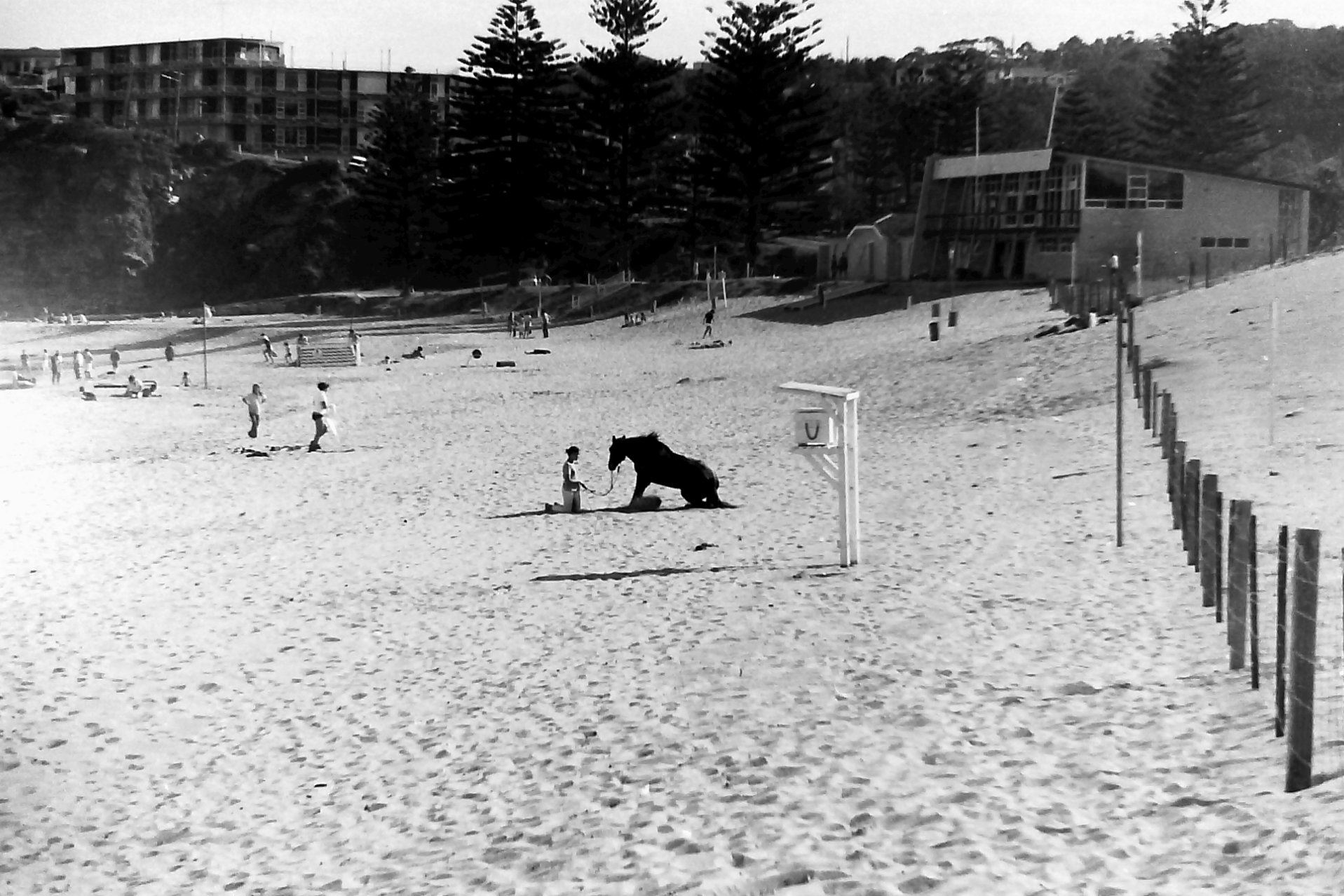
1970 - Horse on Avalon Beach, south end. Photo by and courtesy Gary Clist
First School Captain Scott McCallum, in 1973, the first year that Barrenjoey had a school captain, said he shared that honour with Jenny Hugel.
The teachers explained the students were consulted about developing the first school rules for Barrenjoey High School and also developed the school’s first student organisations.
'‘We were consulted,’ Scott said, ‘but we were only really young. There were no senior students, as we were the first year in 1968. We were little kids of 11 and 12 feeling like big shots as there was no one older telling us what to do.
With encouragement from the teachers we developed little organisations like the Students Council, so a few of us did get together and discuss and debate various matters of concern. There was a sense of developing some of the framework by which the school would run.’
‘' I think we did help establish some of what is the school spirt, and as younger students came along we all helped and encourage3d them in different ways. Those that were good at sports helped younger students with sporting talent. Personally, for myself, I had a lot of pleasure in helping some of the younger students become proficient debaters in the school debating activities.
I think we all did different things to foster the younger generations in different ways.’
Were you one of those who went down the beach to go surfing at lunchtime?
Scott: ‘no, I was one of the goody-goody one, possibly a minority, to be honest. But of course, I wish I had done more of that – definitely. I think that’s definitely the way to learn, to take some time away from the school and schoolbook learning.’
Sue was explaining there were students who rode their horses to school and there was a paddock beside the rifle practice range for them. Was Avalon Beach still alike a holiday resort then, a place people still came to get away from citified areas?
Scott: ‘Yes, in many ways. The whole of Australia was very much like that in fact; it was known as a laid-back country and the northern beaches most definitely epitomised that.
I think that has changed over the years, and quite rapidly. I’ve heard that Australians work jus as hard, if not harder than other people in other parts of the world. The land of the long weekend has become the land of working on the weekend.’
Mike – were you one of those that went surfing at lunchtime?
Mike: I was a Prefect so I used to let them out to go surfing at lunchtime. I used to take on the duty of the gate near the beach.
What did the Prefects’ duties involve?
Mike: letting people out to go to the beach.
Allan: I was down the beach first thing every morning. I think I took about 5 weeks off at one stage, and went surfing.
What was the best thing about being the first year at a brand new school?
Mike: not being harassed by the years that came before us, because there weren’t any. That set us up for not doing the same to those that came after us.
Allan: I remember always trying to avoid the music class – every week we had to write this lady an apology.
What instruments did you have?
Allan: ahh… maybe triangles.
And when the next year came in?
Allan: well we knew a lot of them already, they were just coming across from Avalon Public School. There was a little bit of controversy between Newport people and Avalon, and me, I lived at Palm Beach – so there was tribal stuff. I’d go walking past La Fiesta and Terry (Papadis) and cop grief from the Avalon boys.’’
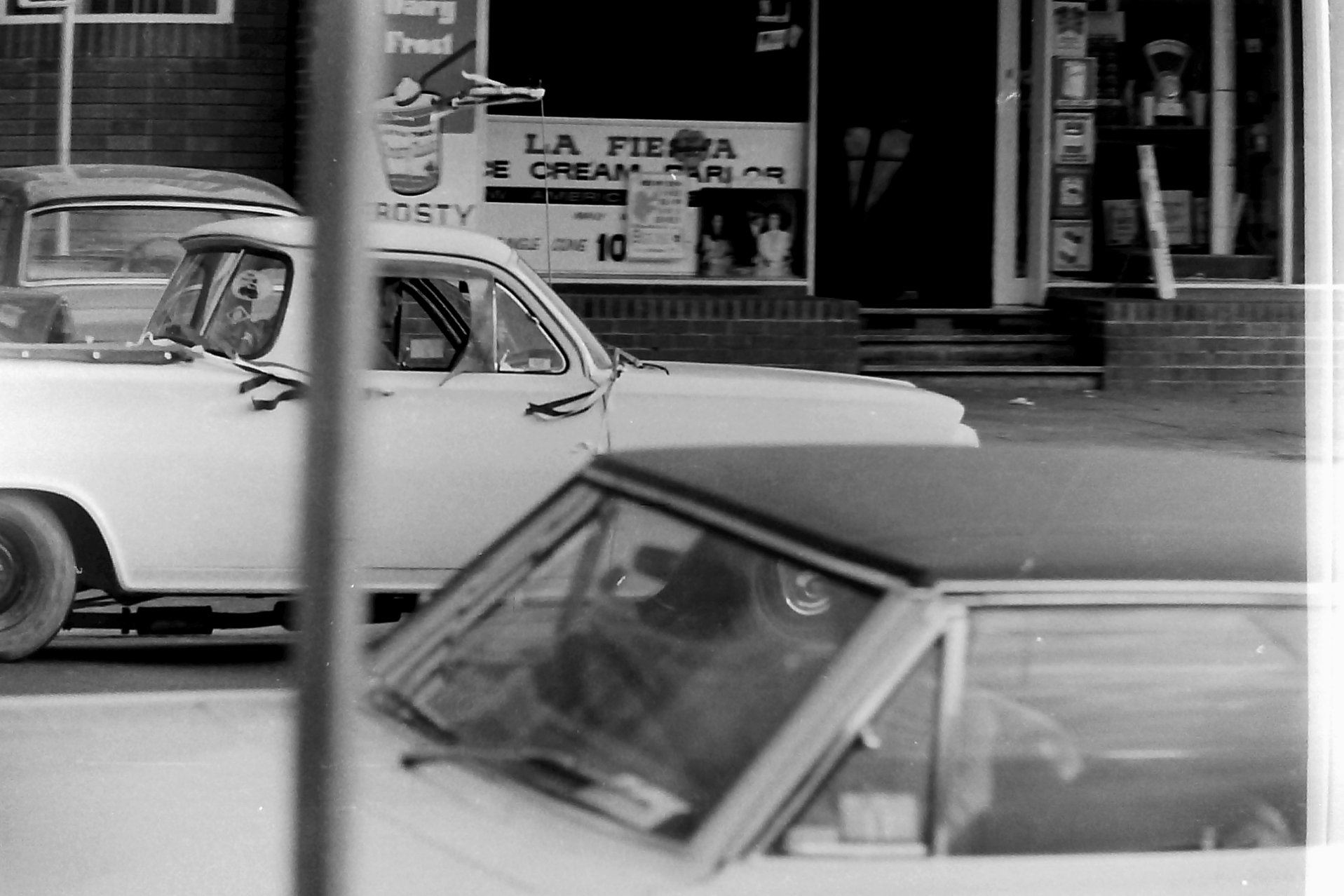
La Fiesta Milk Bar in Old Barrnjoey Road - owned and run by Terry and Pam Papadis, they had three children; Theo, Nic, and Fay. - Alison G. Jenny S-W; Got any photos of the old la fiesta - that was also a local hang out!! John S -; when I was friends with Boyd we hung at Jimmy’s . Later La fiesta was the hang being a grom playing space invader and pinnies . Surfing legends such as Ted Spencer Bommie and David Chidgey Russell Hughes and Brian Bariscool were the hangers drinking Cappuccinos . Great memories. Photo by and courtesy Gary Clist
What was it like being at school while they were adding on the buildings for the soon to come new classes?
Allan: it was noisy; they had a pile driver going all day.
Philip, what was the best thing about being the first class going through Barrenjoey?
Philip: the best thing about it was we were all experiencing the same things, our group, all of us gong through the same learning experience at the same time; we had no role models at the school. As a consequence we’ve all become really good friends, and stayed that way for 50 years. The teachers on the whole were very good, great people.
Who was your first Principal?
Philip: we had Mr. Browning originally and Alan Jessup was the deputy. Mr. Browning was very good. I was one of those who rode their horses to school. When the school was built they’d excavated the sandhills towards the end of the beach. There was a rifle range for cadets that was sort of incorporated into the playground. So we used to put the horses in there; so that was fairly unique. People can’t believe that we used to ride to school. I lived close by then, in Park avenue, and there quite a few of us that horses in paddocks around the district. We used to races along the beach all the time.
Was there much more bushland then?
Philip: yes, there was. The road going north hasn’t changed that much, but there was lots of bush, lots of vacant land, so lots of room for fun.
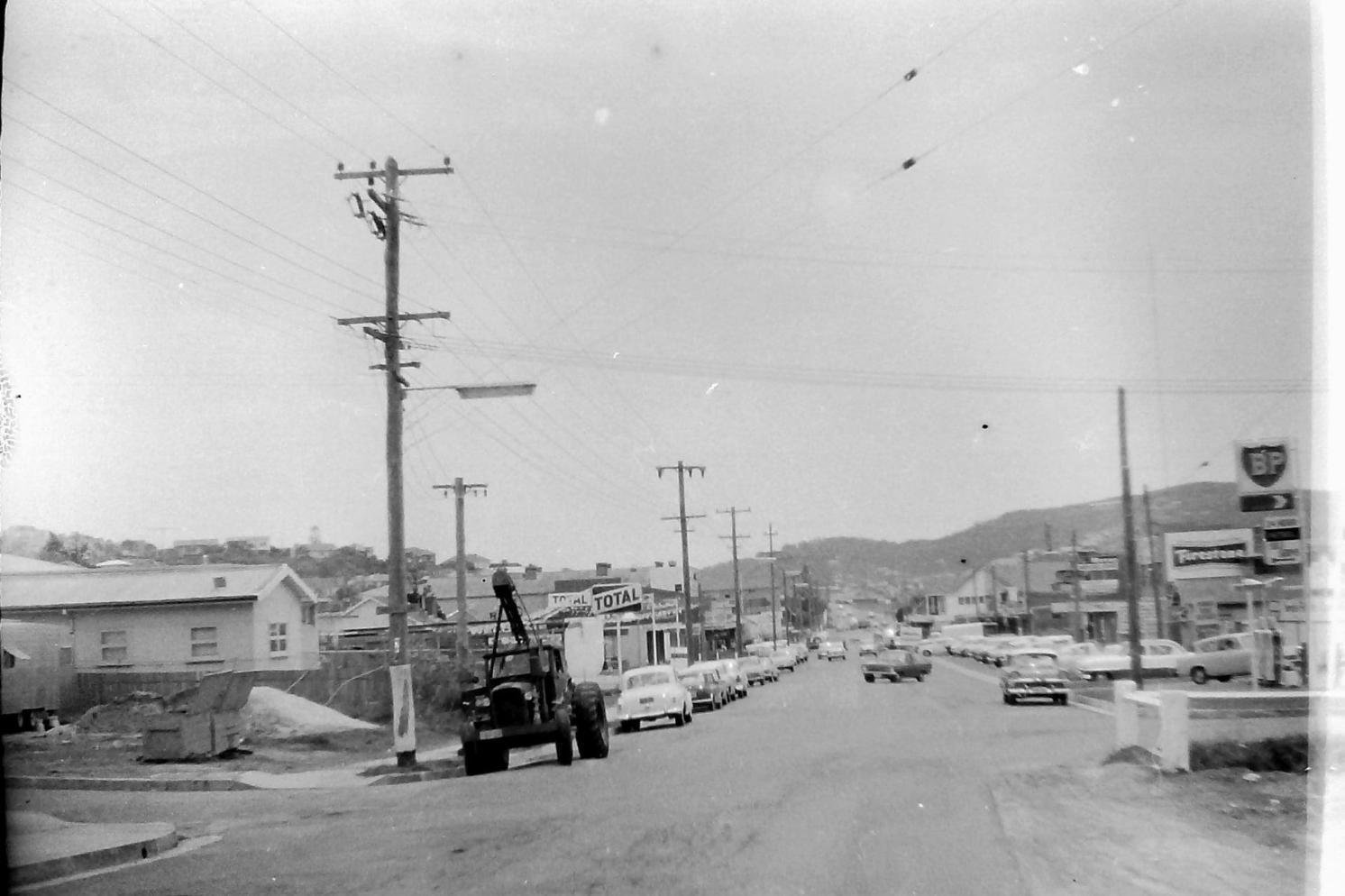
1968 Old Barrenjoey road from outside Avalon Public School looking north. Photos courtesy Gary Clist
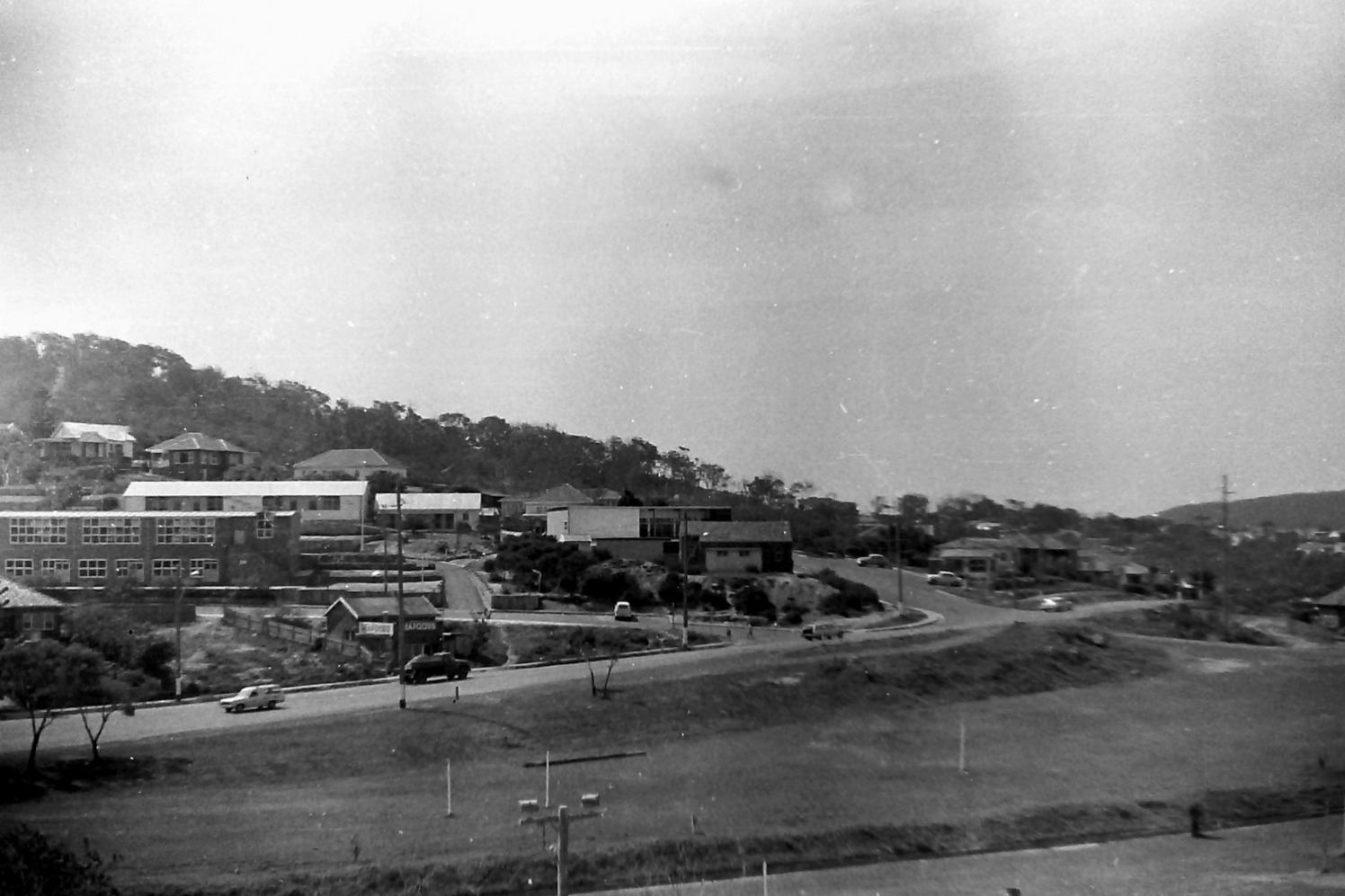
1968 Catholic School on left, Central Ave and Kevin Ave.
Sue Martin, who taught as one of the English Teachers at Barrenjoey from 1970 until her retirement, recalled kids using their surf boards when the creek flooded up and over the front playing field.
‘’On a good surf day, playground duty had to include North Avalon car park where the kids would go to check the surf.
Originally, surfing was banned as a sport in NSW schools. Milton Brown, a teacher at Barrenjoey, was a member of the NSW School Surfing Association who lobbied the NSW government and Department of Education from 1976 until 1980 when Barrenjoey High School became the first school to have surfing officially approved as a school sport. ‘’
‘’In the 1980s, Claire Carmichael, on the English staff, wrote a series of murder mystery/comedy plays using the strengths of the students who auditioned. The plays were subsequently published and performed at many other schools.
‘’At that time Barrenjoey had no school hall. The plays were therefore performed in the Avalon Public School hall. On one memorable occasion, there were the usual number of dead bodies on stage when a rat suddenly ran out onto the stage. The audience were transfixed and the dead and live bodies on stage were horrified. As producer, I was standing in the wings, and I whispered “Don’t anyone move!!” Fortunately, the students were more intimidated by my hissed directive and no one moved. The rat, after making his appearance, disappeared backstage and the play continued.
The battle to get a school hall took many years and many fund-raising activities. At one stage it was suggested that the school tennis courts could be sold. Fortunately, the majority of the staff were appalled by the proposal which was subsequently dropped. Eventually after much lobbying, the State Government agreed to the building of a school hall.’’
Mia, who used to be Debbie Jenkins, and Jane, who used to take off down the beach to have a swim together.
Mia: I lived in Avalon Parade and my mum was a teacher at Barrenjoey, Mrs. Annie Jenkins.
Ros Andrews (teacher): There’s a nice photo of her from the 2018 teachers reunion.
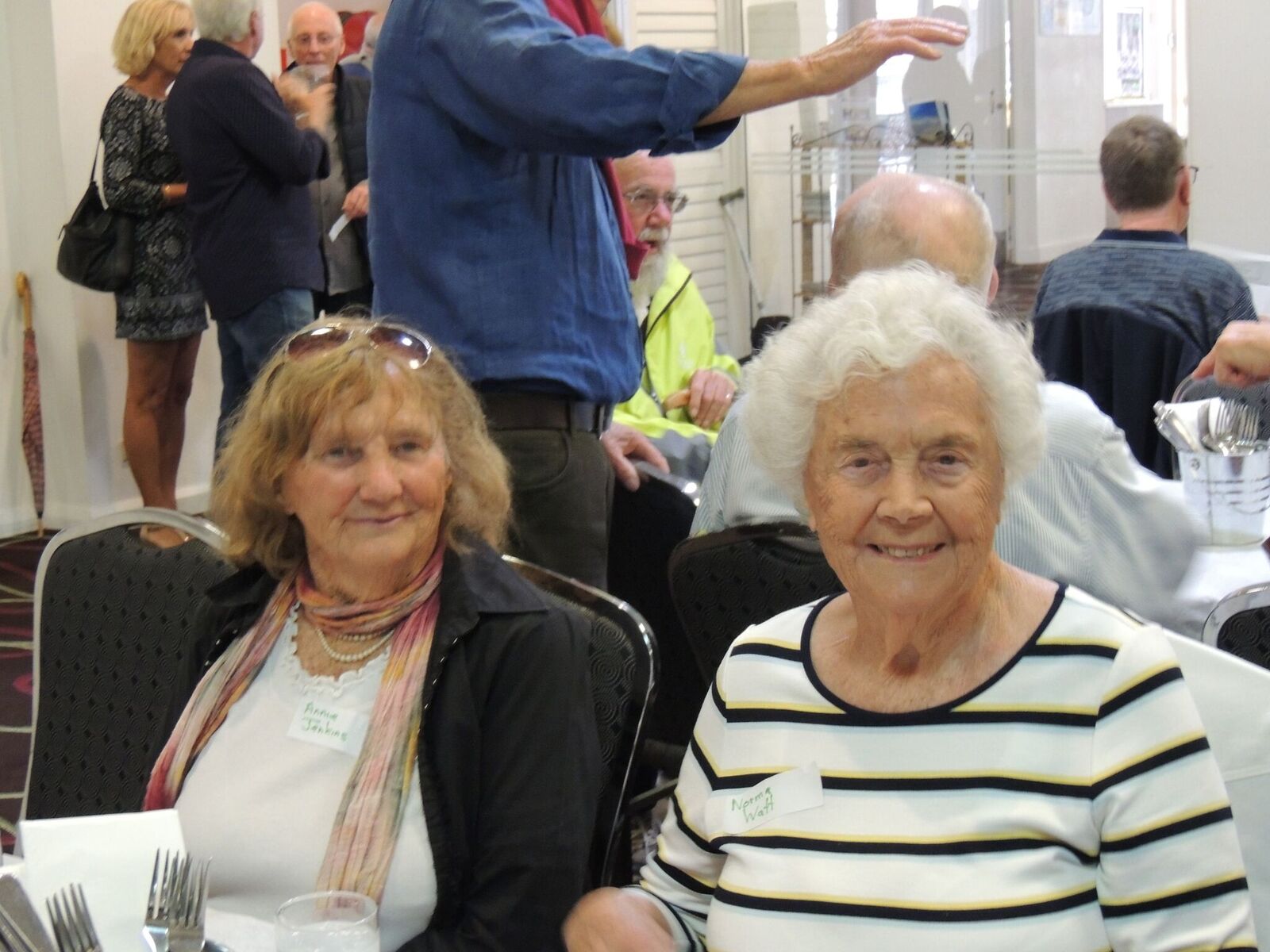
Annie Jenkins (90 yo) and Norma Watt (95 yo).
So now you’re Mia?
Mia: yes, I changed my name in 1990; I hated Debbie, I didn’t even turn around when somebody said it, I hated it.
What was it like having your mum teaching at the school?
Mia: really difficult, I had to be naughty, Sue (Martin) will tell you that. I had to be a bit naughty because everyone thought I was a goody-goody teacher’s daughter.
Ros Andrews (teacher): her mum was a cool teacher, where other teachers might get them to make a French seam, she used to get them to make boardshorts. And when they did cooking, they didn’t do pikelets, they did sautées. So Mia’s mother was a fabulous mother.
She taught Home Science?
Mia: yes, Home Science and Textile and Design. I wanted to do T-d Drawing but they wouldn’t let us.
Ros Andrews (teacher): During first form they had to wear white gloves to go to the city, and a hat, and they were 12 year olds!
Jane: and we were told to make sure the meal is cooked when your husband comes home – that was Mrs. Yates, remember Mrs. Yates? – and have the children in bed, and if you have burnt the meal have some scrambled eggs ready. I remember thinking even then, as a 12 year-old, ‘what a …’
Mia: yes, and make sure you put your underpants in the middle of the Hills Hoist when doing the washing so no one can see them.
What did you think of the red beret that was dispensed with after the first year?
Mia: I don’t think I ever wore it.
Jane: no one ever wore it. And we had a red jacket and a little red bowtie and a pan collar. My mum was so laid back; so first form, everyone arrived in their new school uniforms. Mum didn’t get around to it – she was at the beach or playing tennis, so I turned in a dress for the first few weeks. A new kid on the bock, mortified. She eventually got around top it.
Did you two girls go down the beach at lunchtime?
Jane grins: Mr. Kelleher was our Maths teacher. Our friend Jenny went down the rock pools, and we’re swimming of course and came out to the end of the carpark and he’s going (makes ‘come in’ hand gesture) and we’re going (shakes her head ‘no’). we had to go back to school of course, but we had on those triangle bikinis and so had wet patches and that gave us away.
Mia: everybody did.
Jane: we got suspended for a day.
Mia: we spent it at the beach.
Jane: I had to take a note – mum just laughed.
Did you go surfing?
Jane: oh no.
Mia: I had a boyfriend that taught me to ride. It was called a pintail. I wouldn’t be able to do it now.
Jane: we rode surf mats, those blow-up surf mats. They were the things that we had. We grew up on the beach. Debbie (Mia) and I would go down from dawn to dusk.
Mia: we used to hold our breath because we thought if we held our breath we’d get browner.
Jane: and you used to spray yourself with Pure and Simple.
Mia: I’d get so brown, our noses would be peeling.
Jane: we were shocking.
Mia: we were terrible.
Why did you think you were going to get browner of you held your breath?
Mia shrugs: don’t ask us….
Jane: it was a theory.
Mia: we were brown as berries. Remember we used to sit on the beach with the Sherros, the Sheridan twins, and we’d eat watermelon and mangoes, oh yum
Jane: we had the perfect lifestyle I think.
Ros Andrews (teacher): they were very good students as well though – they were exceptionally talented and intelligent and all of them became wonderful adults.
Mia: I think that helped us, having that bit of leeway, it helped us grow up, be responsible for ourselves.
Jane: and al that salt water and good food, we grew up healthy.
Ros Andrews (teacher): I took a group into town once to a theatre. The actors came out afterwards and said ‘but your students look so healthy compared to the inner-city kids we see’. I explained we’d brought them in form Avalon.
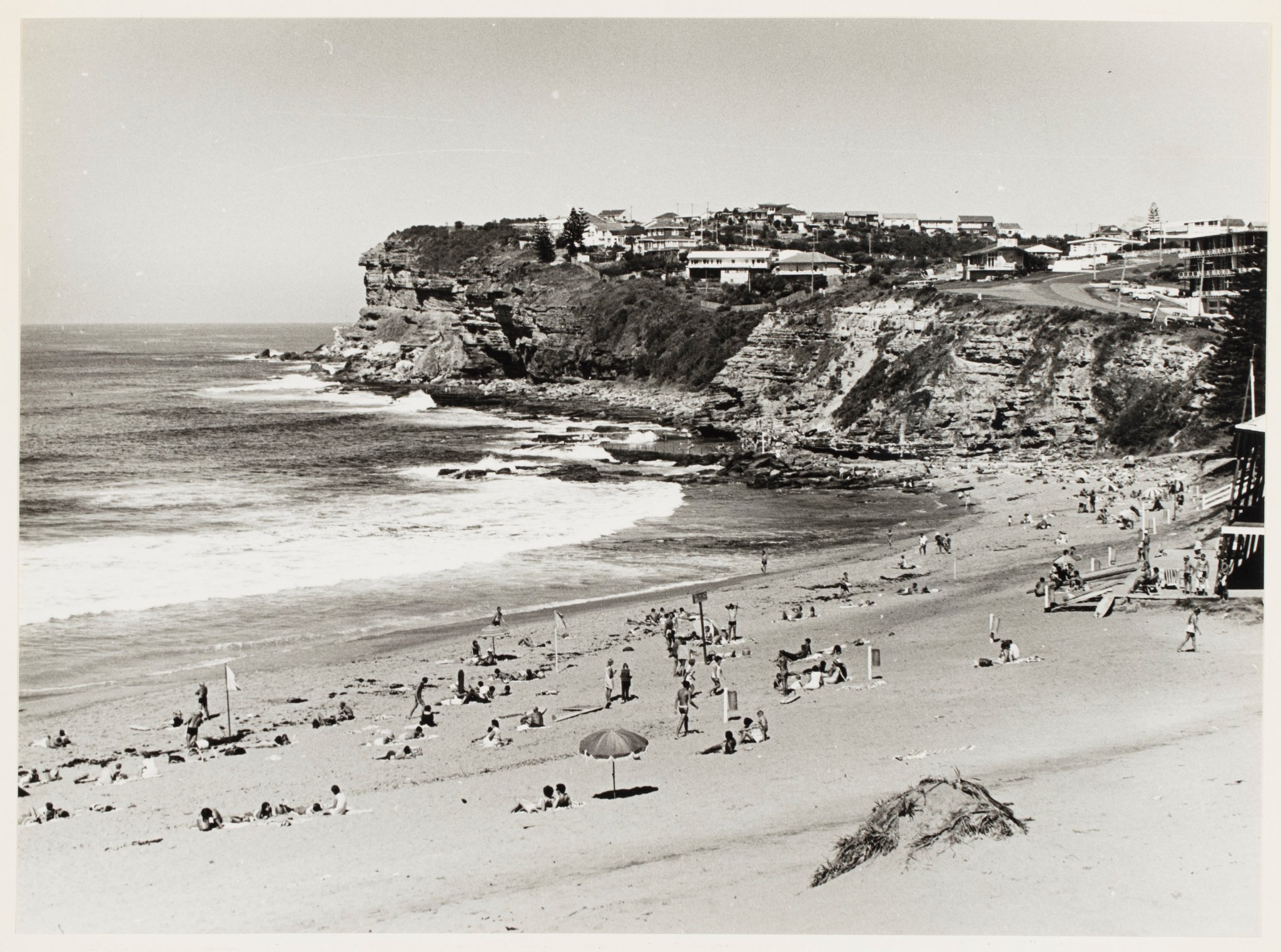
Avalon Beach in 1967. Photos courtesy: Gary Clist
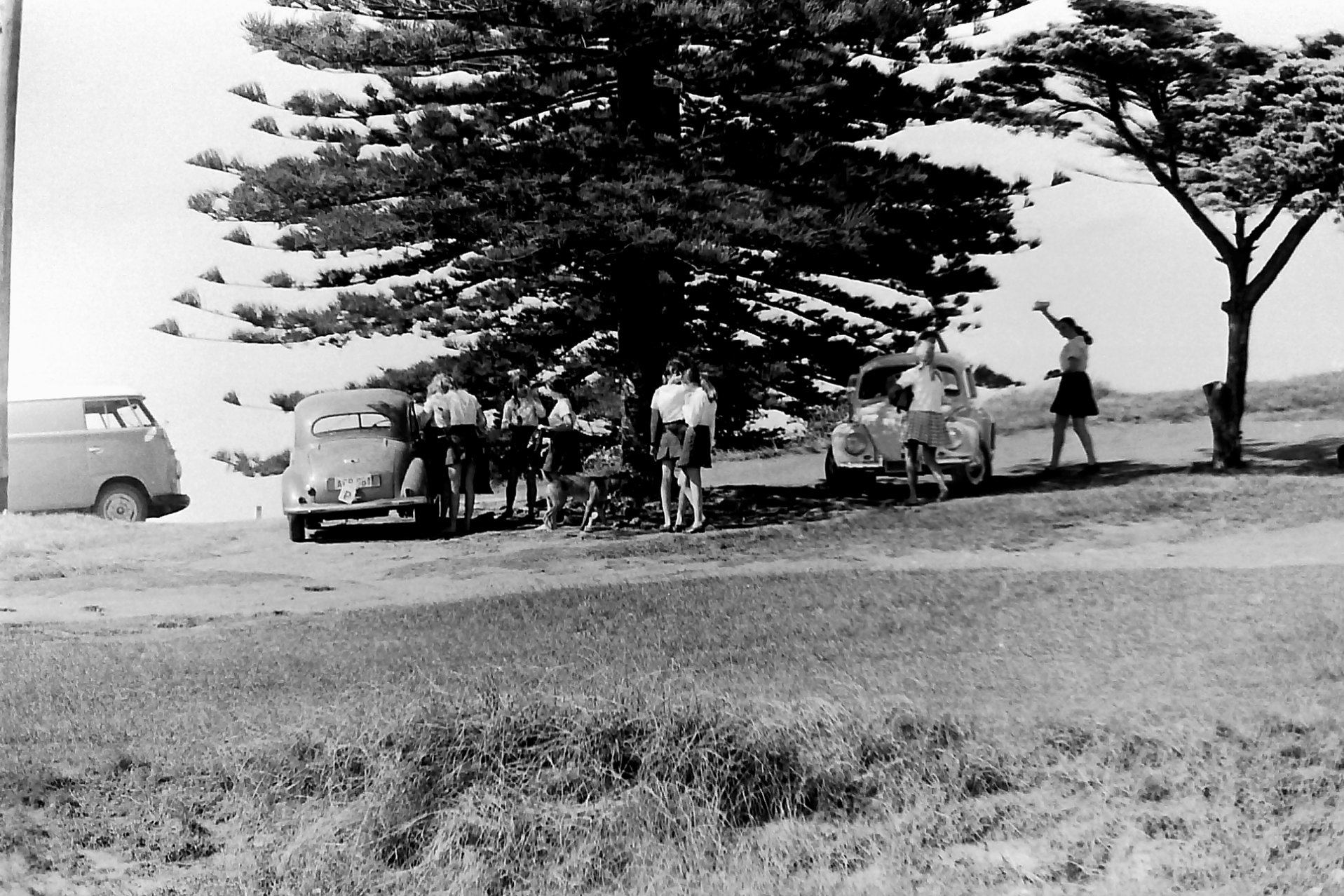
Avalon, high school girls 1970, Morris Minor in the middle of two VWs
Lauren what do you remember about being in the first year of Barrenjoey High School?
Lauren: I wasn’t there until the second year. I was at Mater Maria until I threw a tantrum until my parents let me go to Barrenjoey. I loved it from the start – it was just so free and easy to be there. I made lifelong friends. Sarah and I were always at the back of the cross-country, there was a third one of us – we’d run behind the sandhills and then just walk. We’d get a bit further along and the teachers would see us and say ‘go again and we’d have to do the whole lap again.
How big were the sandhills?
Lauren: big, they were taller than they are now. We had to run through that sand. We used to have our swimming carnivals at Bilgola beach under that outcrop of rock, it was always in the shade, it was freezing cold, and they’d say ‘dive in’ and we’d be ‘oh no’.
Some people were good at things – Sarah and I weren’t particularly athletic in anything. I remember we had people who would ride their horses to school. I remember Maria Brand, Trott is her surname now, she sued to ride to school holding a tether and chain in one hand so she could tie her horse up, and a briefcase in the other.
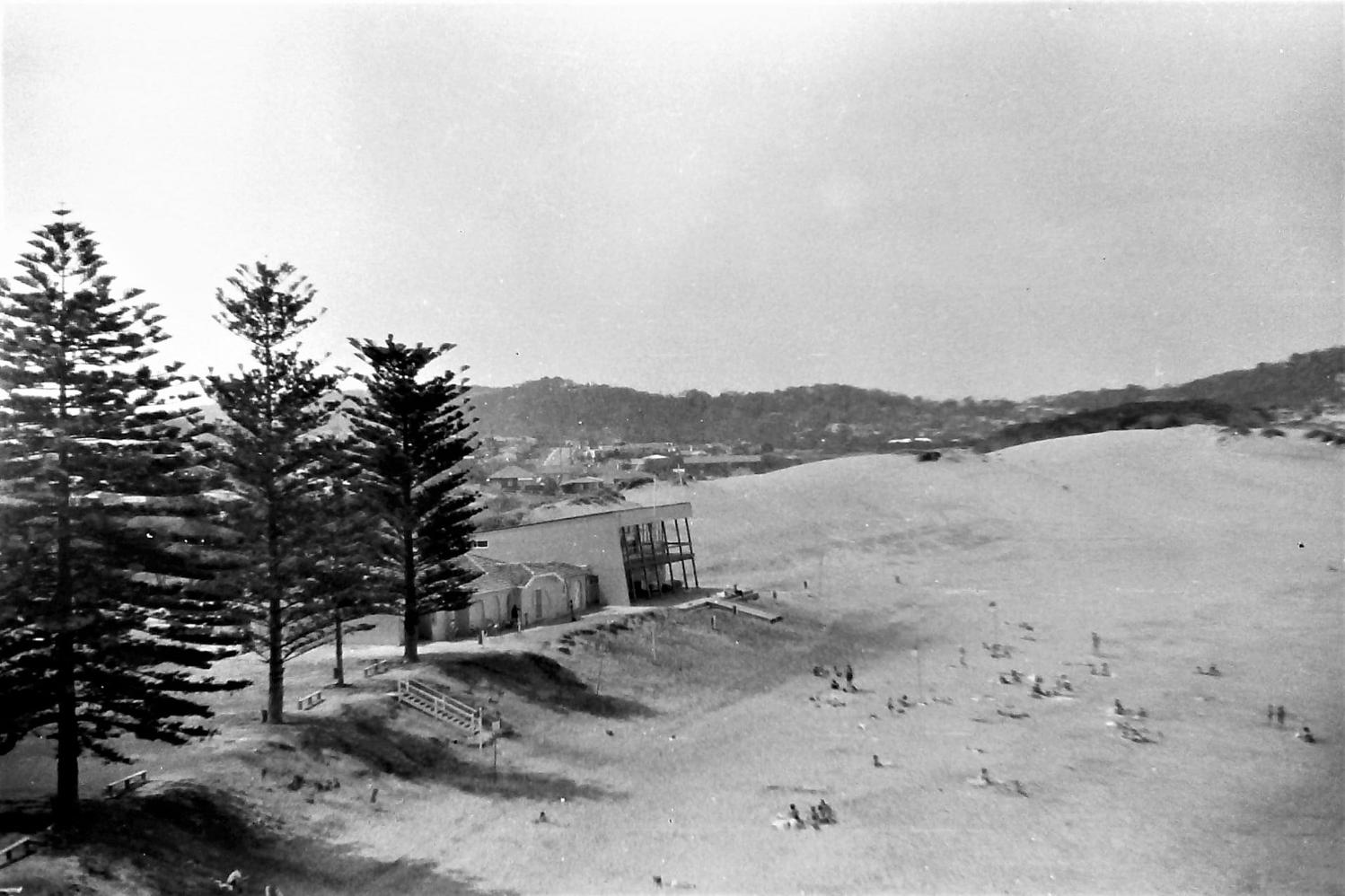
1968 - Avalon beach showing both 1st and 2nd clubhouses. Photos courtesy: Gary Clist - below; from the north end 1970-71
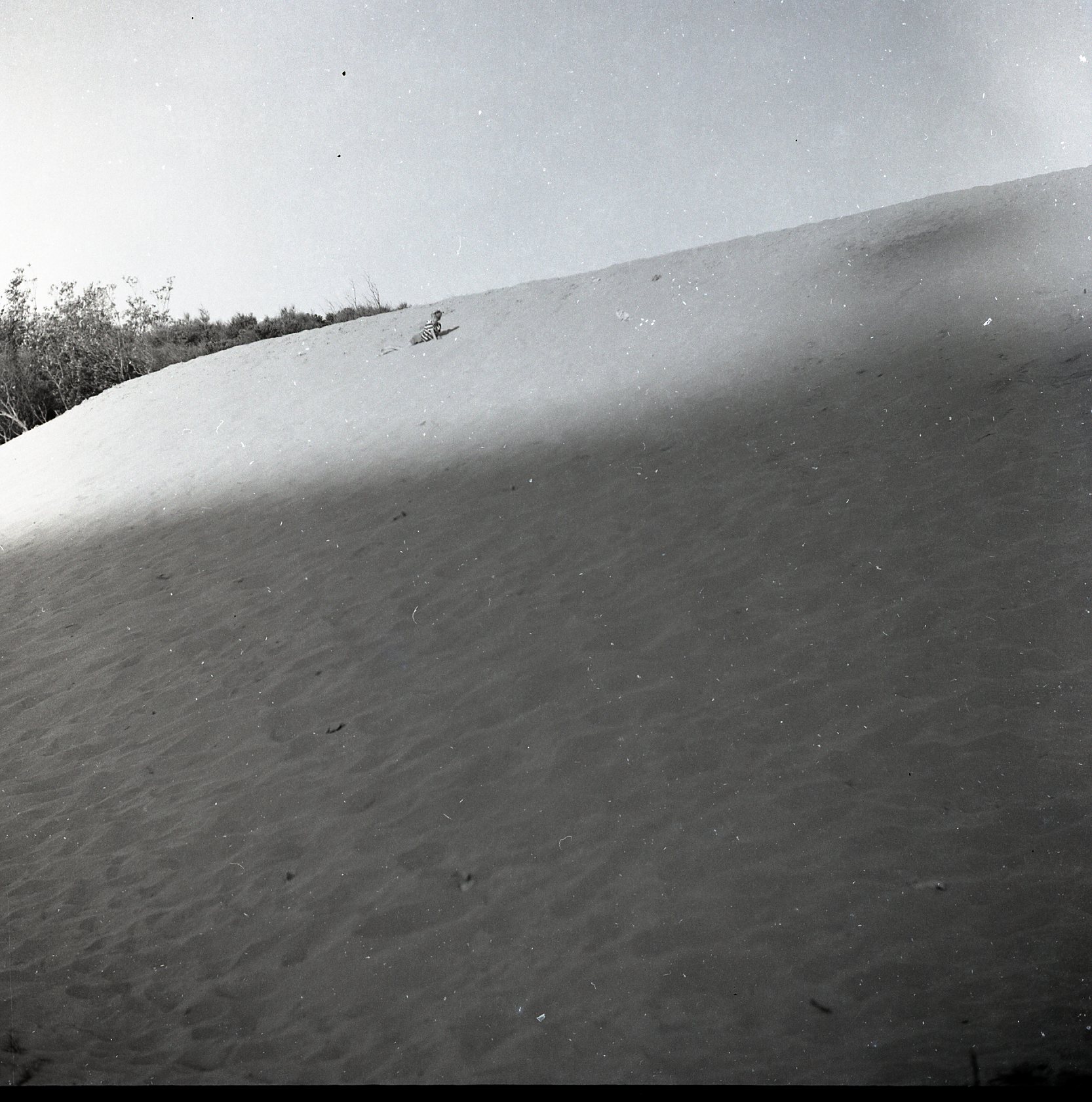
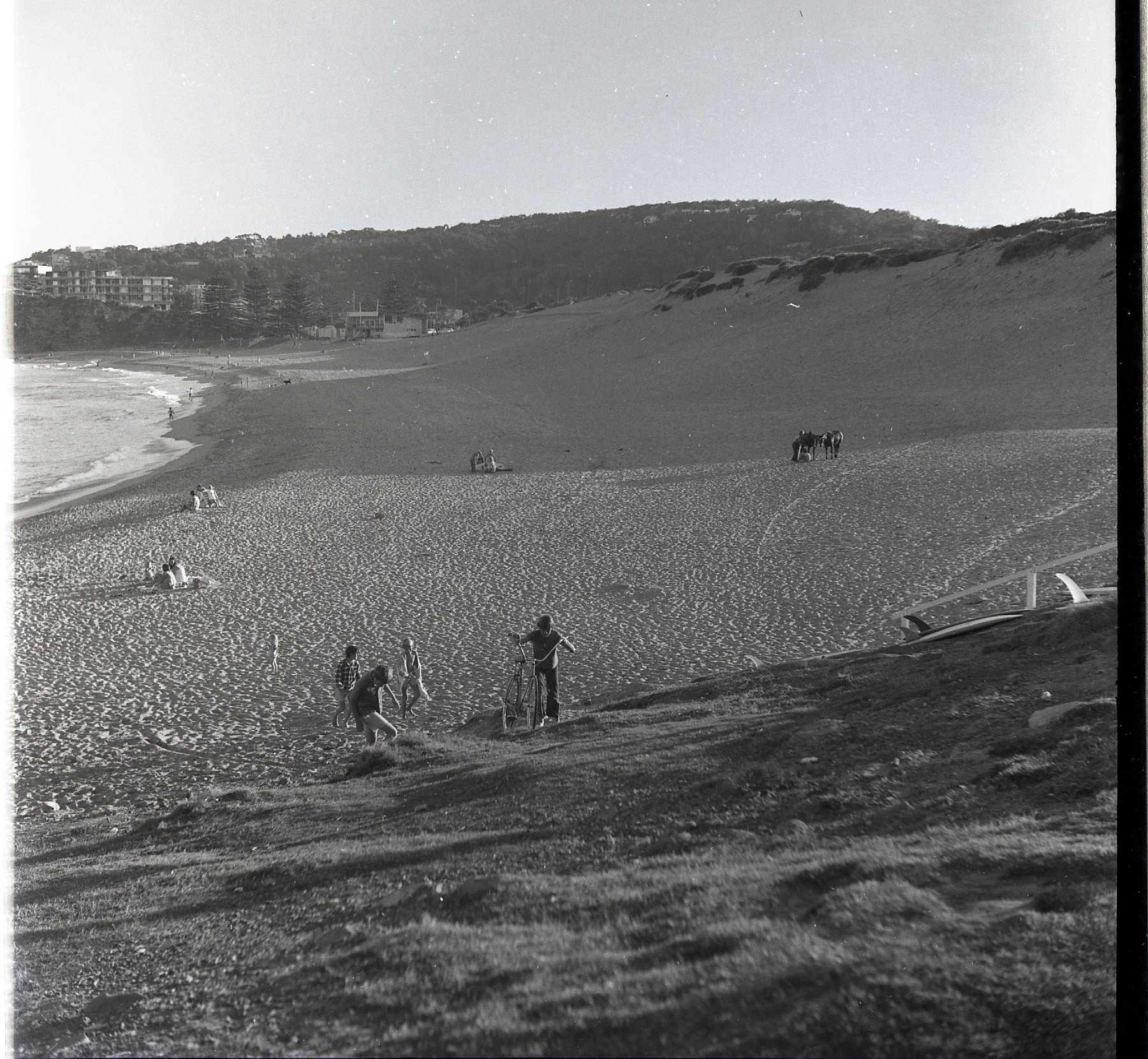
What did you do on the weekends?
Lauren: well I was a bit different as I didn’t have any horses in Avalon but would go to Terrey Hills and Frenchs Forest on the weekend and ride horses there. So I wasn’t really tied up with the rest of the girls on the weekend. I do remember I was the only girl with white legs. I had jeans on all the time and they were at the beach.
So you weren’t one of the ones that went surfing at lunchtime?
Lauren: no, but I remember the boys doing this. They’d climb out the windows and go to the beach and come back, covered in sand, and the teachers would say ‘where have you been?’ – ‘nowhere’. They’d be wet, covered in sand; ‘nowhere’.
I remember Mr Couell, he was the Sports Master, chasing kids. They were either coming back or racing away from the school, and he was quite fast – he’d get them before they got out. His son Michael was one of us too.
I remember our muck up day – Sixth Form, or year 12 as they call it now – he let us tie him up down in the village, so he was great. He put a bit of fear into them, which was good for them.
So ‘cool’ as in the way you pronounce his name?
Lauren nods; Our first Headmaster was Mr. Browning, he was scary, some of us were scared of him. He was strict and I was a bit n fear of Mr. Browning. Peter – what was the name of our second Headmaster?
Peter: I can remember getting the cane off him.
Why did you get the cane?
Peter: for being too good in class.
Did you go down the beach surfing at lunchtime?
Peter: never!
Allan: we never ran the cross country, we’d always go for a surf.
Jim (teacher): I can recall a lunchtime duty where you had to run down to the end of the playground, because they had their surfboards hidden there, all ready to go, and throw yourself ahead of the kids and throw yourself at the gateway and say ‘you’re not going out there to surf until after school’.
Peter: I remember Mr Couell and the cross-country, which used to be more than one lap, and we’d sneak off and have a surf and come back after the last lap acting really buggered, and he’d say ‘I didn’t see come past the second time’ and send us around again.
Kim: the grounds were way bigger the - they so big.
Lauren: Rory used to go and then try and sneak back in the window and we’d all start with a ‘Rory!, Rory!’
Sarah-Lulu: Rory was our larrikin.
Rory: they all tell tales on me.
Sarah-Lulu: he would push me under the bubbler but affectionately, in fun.
Rory: we’ve known each other since kindergarten, that’s along time.
What was the best thing about being in the first graduating class for you Sylvia?
Sylvia Capel: the best thing for me was, I think, I got to be the athletics star. I didn’t have any competition.
Rory: we were a very good sporting school.
Sarah-Lulu: we were a very good sporting school.
What sports were you competing in?
Sylvia: athletics, high jumps, hurdles, the 200 metres…
Rory: when we had the inter-high school competitions we beat all the other high schools in the athletics and the swimming carnival. They all had six years and we only had four.
Where were the competitions held?
Sylvia: at the Narrabeen Fitness Camp.
Rory: it was the zone competition, so all the schools competed, and we whipped their a**e.
Apparently, the other kids would chant for you when you would go surfing and try and sneak back in Rory?
Rory: oh, that was… we had a new teacher once, and there was four guys in the class who had just gone surfing, and we had white shirts, grey boardshorts and band aids on our toes so we could wear thongs. We’d just throw our white shirts back on and there would be a pool of water around all of us. Four guys sitting there, still dripping with salt water.
.jpg?timestamp=1664660714099)
North Avalon Beach, 1970-71. Photo by and courtesy Gary Clist
Sarah-Lulu: my larrikin.
Rory: we’ve known each other since kindergarten, that’s a long time.
Which kindergarten?
Both: Avalon Primary.
Sarah-Lulu: he used to dip my plaits in the inkwell …
Rory: and here we are, still naughty.
Sarah-Lulu: we’ve been friends for 63 years, and we haven’t seen each other since our last reunion, but it’s like yesterday. Every time we all meet up again it’s very special, and unique. Some of the people here today we’ve not seen for 52 years, extraordinary, but these people are special to me, they’re like family. Scott, our school Captain, when I see him again we’re still children – it’s nice to have someone who remembers you when you were young; we’re like two children, and we are family.
First ever official Barrenjoey High School Muck-up day after exams are done:
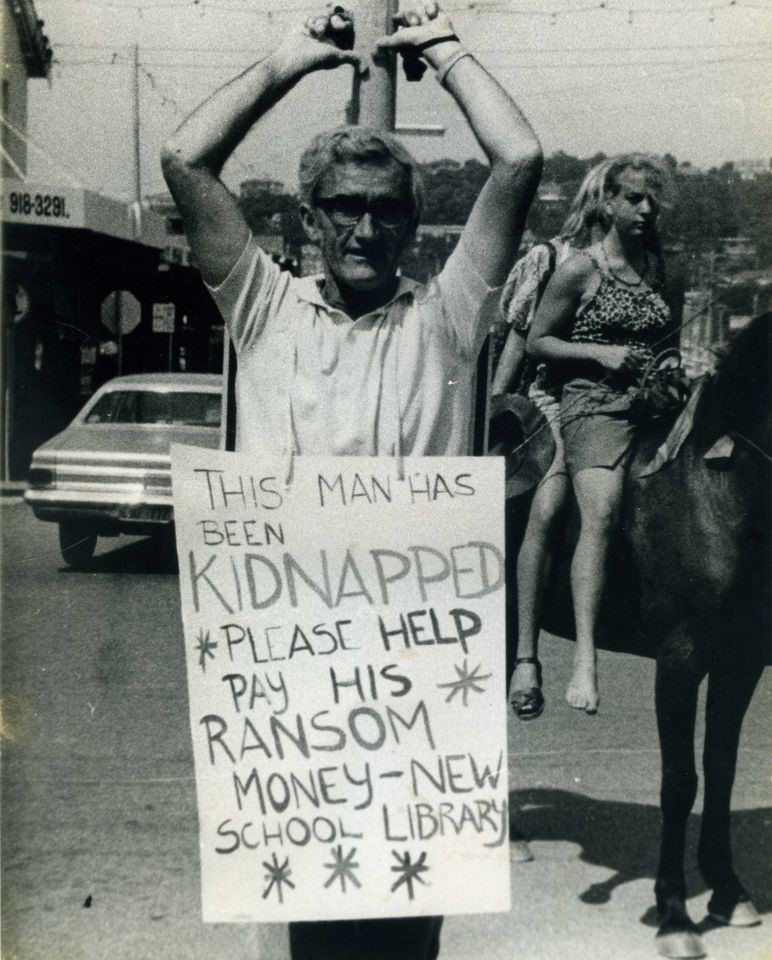
Sue Martin; ‘’Tony Burley, a former teacher sent me this wonderful photo from the first yr 12 muck up. Bill Couell was a PE, Science teacher. His son Michael Couell was in the first yr 12.’’
''They are a dear bunch. I was so delighted to learn about their lives since school. They have achieved success, many of them quite significant success, and happiness which is what one hopes for. - Sue Martin, Barrenjoey High School Teacher (1970 - 1996)
Over to you - class of 2023!
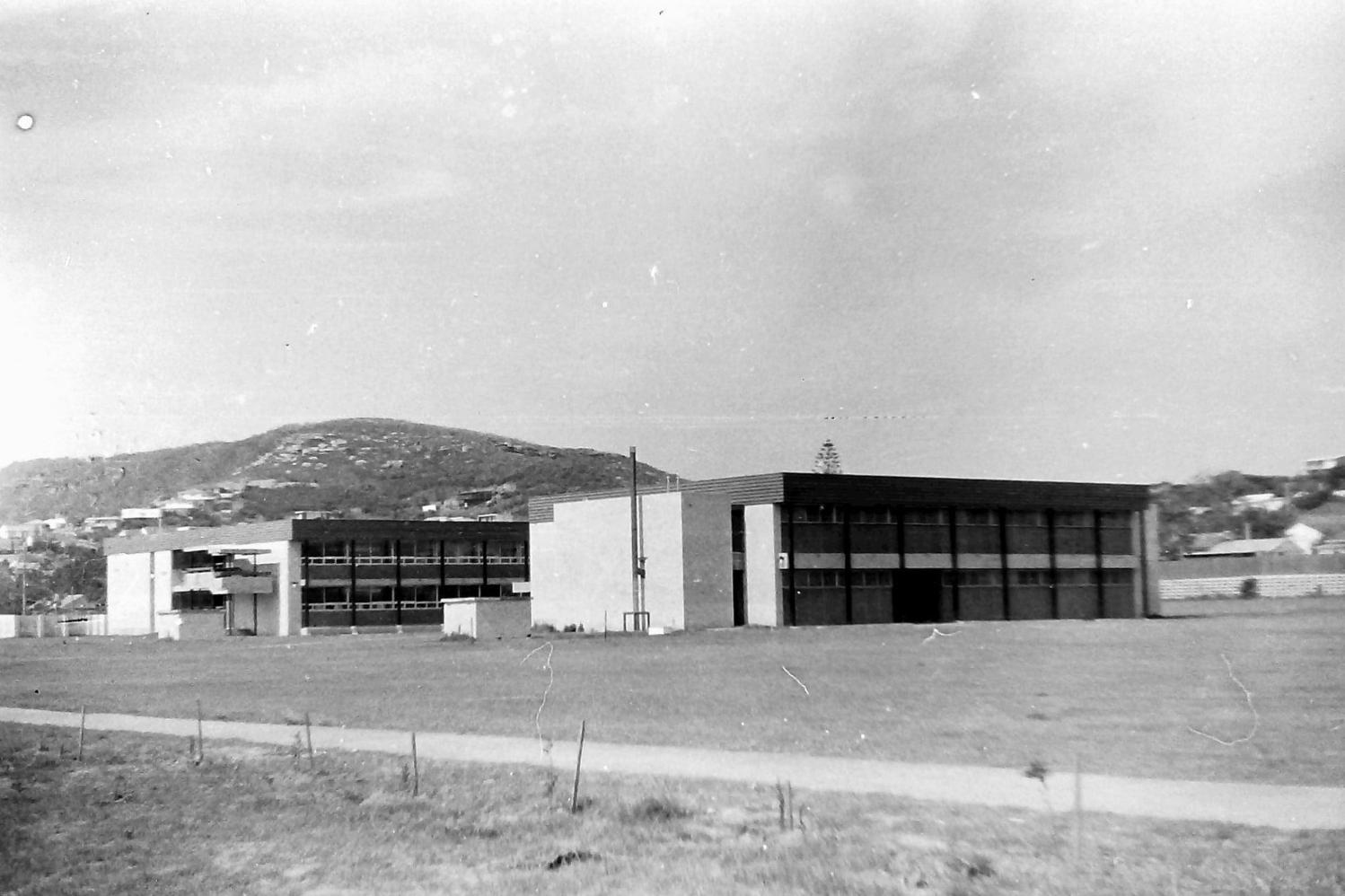
1968 - first buildings of Barrenjoey High School. Photo by Gary Clist (who worked at John Stone's music store.
The first intake for BHS was in 1968.
Sir Harold Wyndham CBE (27 June 1903 – 22 April 1988) was Director-General of Education in New South Wales between 1952 and 1968. In 1954 Dr. Wyndham was appointed to chair a committee tasked to completely review the Secondary education system in New South Wales and make recommendations for improvements. The committee's report, popularly referred to as "The Wyndham Report", was presented to the Minister in October 1957 and gave rise to the Public Education Act of 1961 which was brought into effect in 1962. Key amongst the changes was the objective of presenting all students with the opportunity to experience a wide range of subjects, including visual arts, industrial arts, music and drama, and a wide range of languages. The Five-year Secondary School system was abandoned in favour of adding another year to the course, with major state-wide external examinations at the end of the Tenth (School Certificate) and the twelfth (Higher School Certificate) year of schooling.
What this really meant was "The Wyndham Scheme" created changes to the curriculum which had a more student-centred approach.
When Dr Wyndham was appointed as Director-General of Education there were 455,000 students in the NSW Education system, of whom 100,000 were in Secondary schools. By 1968 there were over 244,000 students in secondary school of whom 64% could be expected to complete the then brand new Higher School Certificate.
The NSW Government Architect’s Branch met this demand by innovating new designs for high schools which could be built quickly and cheaply. These included the so-called ‘doughnut schools’, designed by Michael Dysart.
‘The Dysart schools from this period were innovative in two main ways. As with leading European and North American architects who designed innovative schools in the period such as Arne Jacobsen, Hans Scharoun, Denys Lasdun and Caudill Rowlett Scott (CRS), Dysart moved away from simple linear blocks or finger planned schools, which were typical in the postwar years. In their place he employed a series of square doughnuts in a sort of pinwheel configuration around a large central space. He usually placed a rostrum and bell tower – which sometimes also doubled as an incinerator – in that central space, which could then be used as an all-of-school gathering area. The scheme did away with indoor hallways and replaced them with covered walkways and cloisters. The second innovation was a novel construction process which enabled the erection of a structurally independent roof very early in the process. This allowed work to go on regardless of weather and proved to be a significant efficiency. By these means Dysart provided a new sense of refuge and place definition in the school environment while also devising an efficient system for delivering school buildings. While there was a general move towards ‘demonumentalizing’ school buildings in the post-war decades, the Dysart-designed schools introduced a different set of spatial relationships, one which recalled the deeper traditions of communities of learning.’ - First published in Architecture Bulletin Nov/Dec 2012.
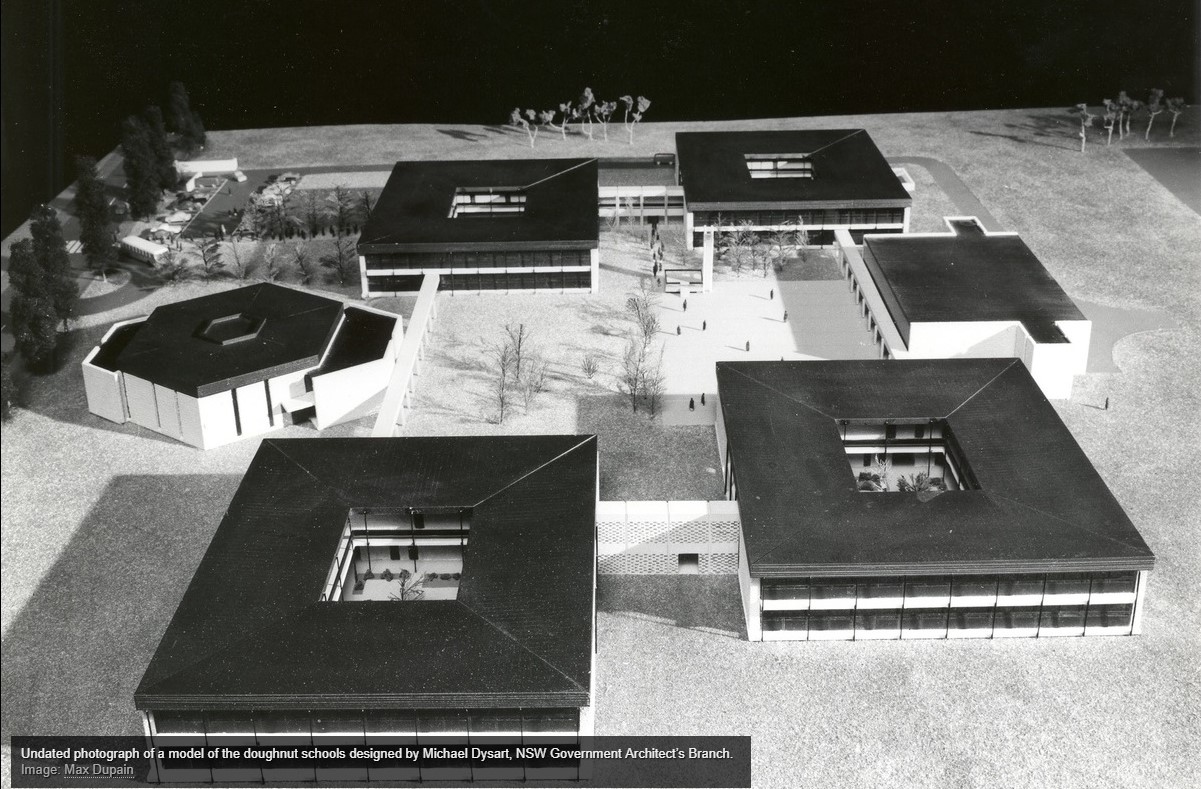
Some of the first Dysart schools were built at Turramurra, Ryde and Pendle Hill. One Dysart doughnut school was also built in Pittwater and originally referred to as Avalon High School during Tender/build stages. We now know this school as Barrenjoey High School.
NOTIFICATION OF RESUMPTION OF LAND UNDER
THE PUBLIC WORKS ACT, 1912, AS AMENDED
IT is hereby notified and declared by His Excellency the Governor, acting with the advice of the Executive Council, that so much of the land described in the Schedule hereto as is Crown land is hereby appropriated, and so much of the said land as is private property is hereby resumed, under the Public Works Act, 1912, as amended, for the following public purpose, namely, a High School at AVALON, and that the said land is vested in the Minister for Education as Constructing Authority on behalf of Her Majesty the Queen.
Dated this twenty-second day of June, one thousand nine hundred and sixty-six.
A. R. CUTLER, Governor. By His Excellency's Command,
C. B. CUTLER, Minister for Education.
The Schedule
All that piece or parcel of land situate in the Shire of Warringah, parish of Narrabeen and county of Cumberland, being lots 1 and 2, section 4, Deposited Plan 13,811, and being also the whole of the land comprised in Certificates of Title, volume 9,994, folios 134 and 135,—having an area of 2 roods 11 perches or thereabouts and said to be in the possession of Avalon Developments Pty Ltd and Northbridge Constructions Pty Ltd. NOTIFICATION OF RESUMPTION OF LAND UNDER THE PUBLIC WORKS ACT, 1912, AS AMENDED (1966, July 8). Government Gazette of the State of New South Wales (Sydney, NSW : 1901 - 2001), p. 2703. Retrieved from http://nla.gov.au/nla.news-article220022810
Department of Public Works—Tenders for Works
TENDERS will be received up to 2 p.m. on the dates specified for the undermentioned works. Envelopes containing tenders must be addressed to the President, Tender Board, Department of Public Works, Box 44, G.P.O., Sydney, and have legibly endorsed upon the face thereof the name of the work for which the tender is submitted. The Government does not bind itself to accept the lowest or any tender. Specifications and plans for all works may be seen in Contractor's Room, Department of Public Works, Sydney, in addition to the other places mentioned. Plans and specifications for works other than architectural works and building engineering services and excluding also those plans and specifications issued in respect of quotations and minor contracts, issued from the Postal and Contractor's Room of the Department, must be purchased at the rates of 50c for the plan with a maximum of $8.40 and $1 for the specification. Where the total cost of the plans and specifications is more than $1 and provided the plans and specifications are returned to the Department prior to the closing date in good order and condition a refund of the purchase money may be made:
Avalon High School—Stage I. (Bills of Quantity, $8 each.) Avalon High School—Electrical Services. (Sub-contract.) Department of Public Works—Tenders for Works (1966, November 4). Government Gazette of the State of New South Wales (Sydney, NSW : 1901 - 2001), p. 4524. Retrieved from http://nla.gov.au/nla.news-article220020370
NOTIFICATION OF RESUMPTION OF LAND UNDER
THE PUBLIC WORKS ACT, 1912, AS AMENDED
IT is hereby notified and declared by His Excellency the Governor, acting with the advice of the Executive Council, that so much of the land described in the Schedule hereto as is crown land is hereby appropriated, and so much of the said land as is private property is hereby resumed, under the Public Works Act, 1912, as amended, for the following public purpose, namely a High School at AVALON, and that the said land is vested in the Minister for Education as Constructing Authority on behalf of Her Majesty the Queen.
Dated this sixth day of December, one thousand nine hundred and sixty-seven.
A. R. CUTLER, Governor. By His Excellency's Command,
C. B. CUTLER, Minister for Education.
The Schedule
All that piece or parcel of land situated in the Shire of Warringah, Parish of Narrabeen and County of Cumberland, being lot 3, section 4, Deposited Plan 13811, containing an area of 1 rood 0 ¾ perches or thereabouts and said to be in the possession of the Department of Education.
NOTIFICATION OF RESUMPTION OF LAND UNDER THE PUBLIC WORKS ACT, 1912, AS AMENDED (1967, December 22). Government Gazette of the State of New South Wales (Sydney, NSW : 1901 - 2001), p. 4846. Retrieved from http://nla.gov.au/nla.news-article220059551
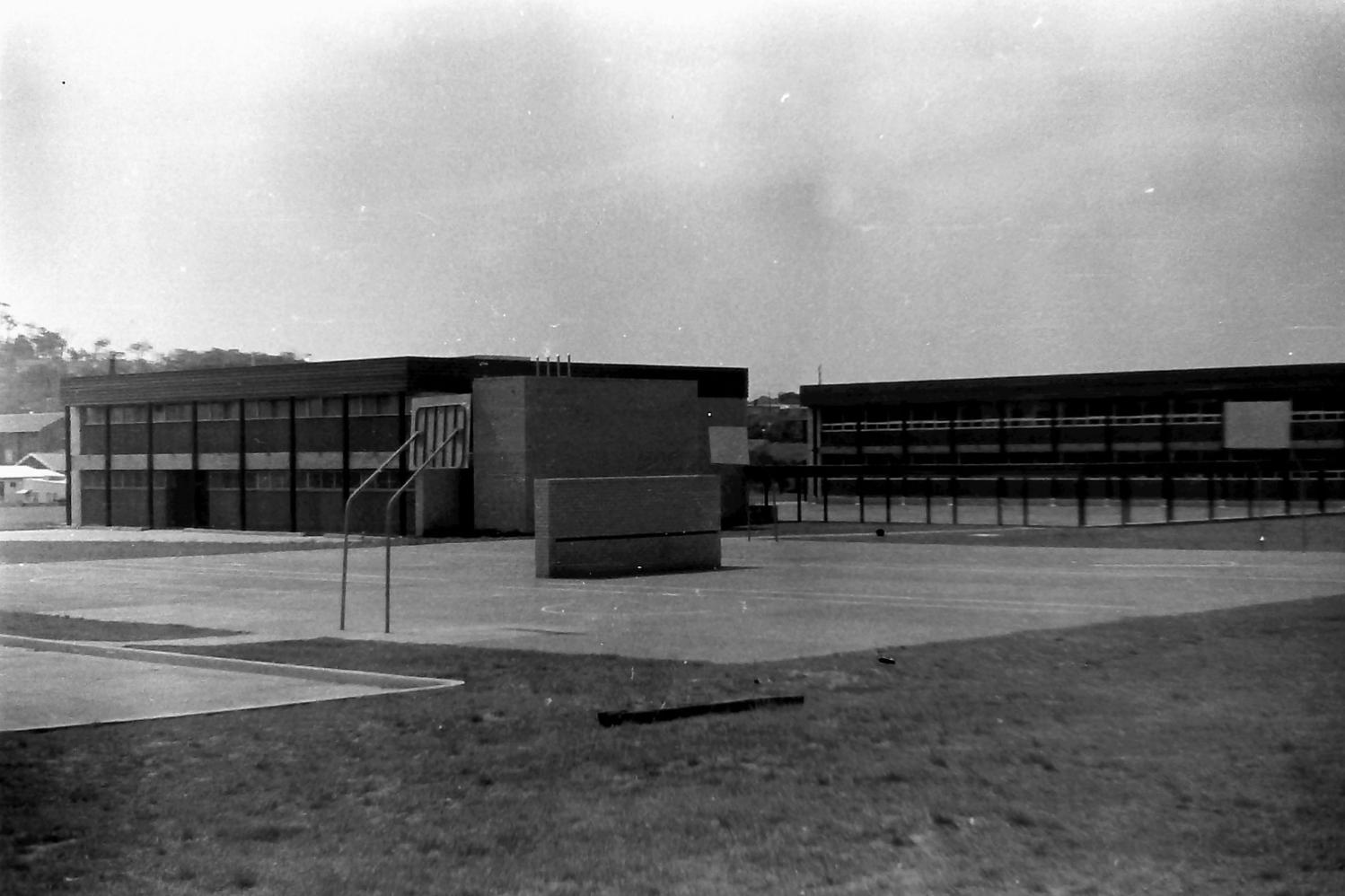
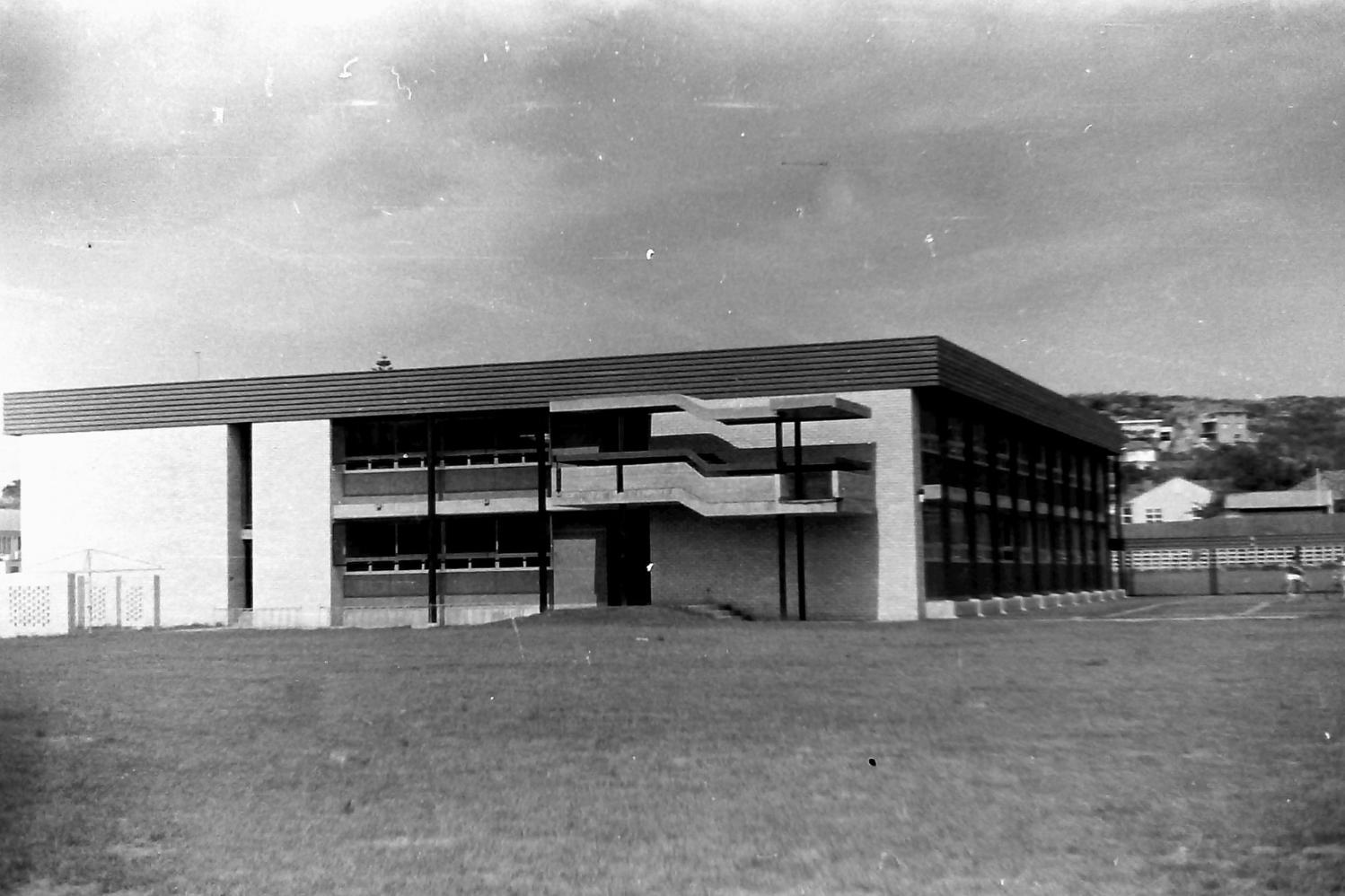
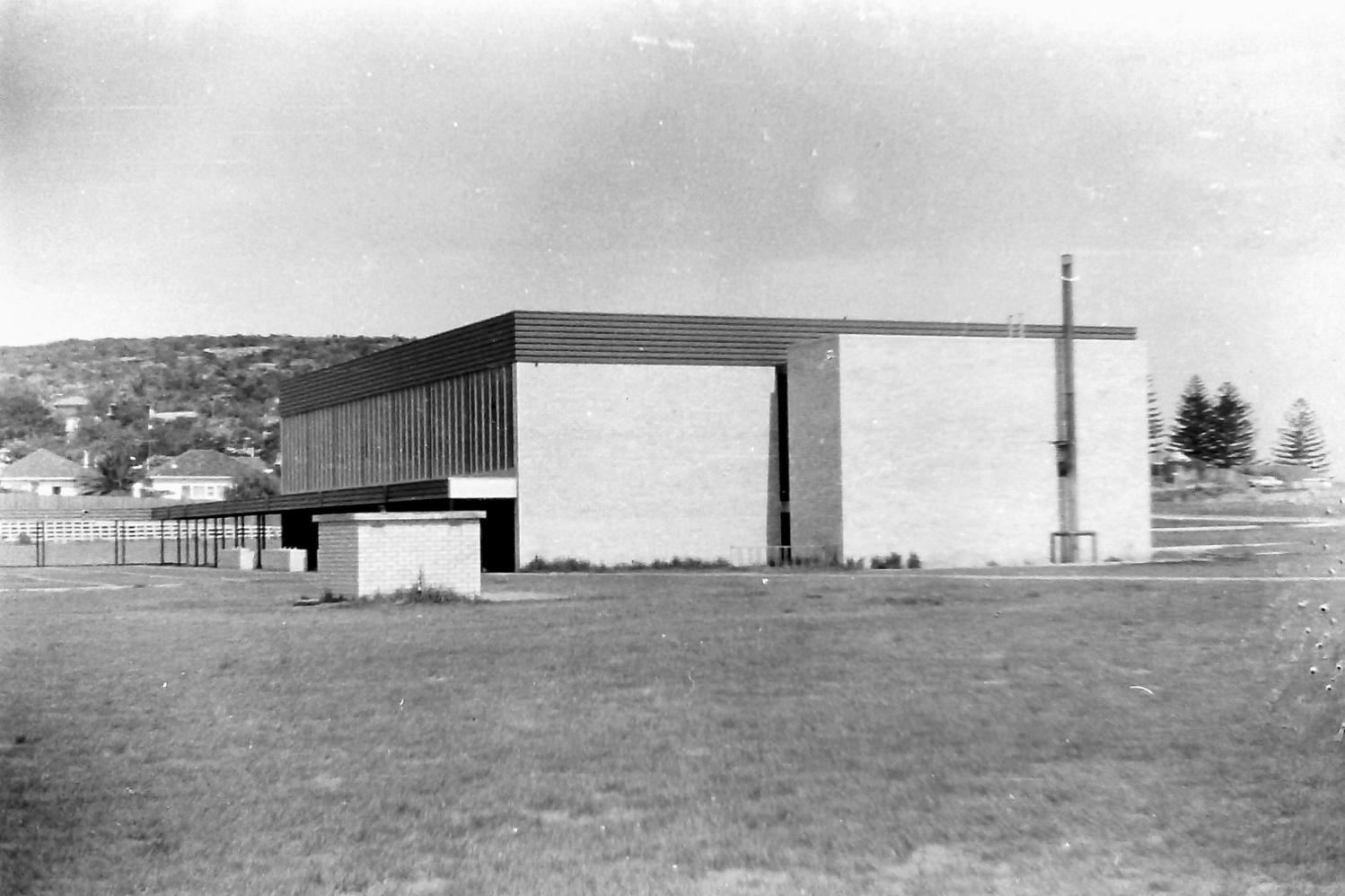
1968-1973 - first buildings of Barrenjoey High School. Photos courtesy Gary Clist
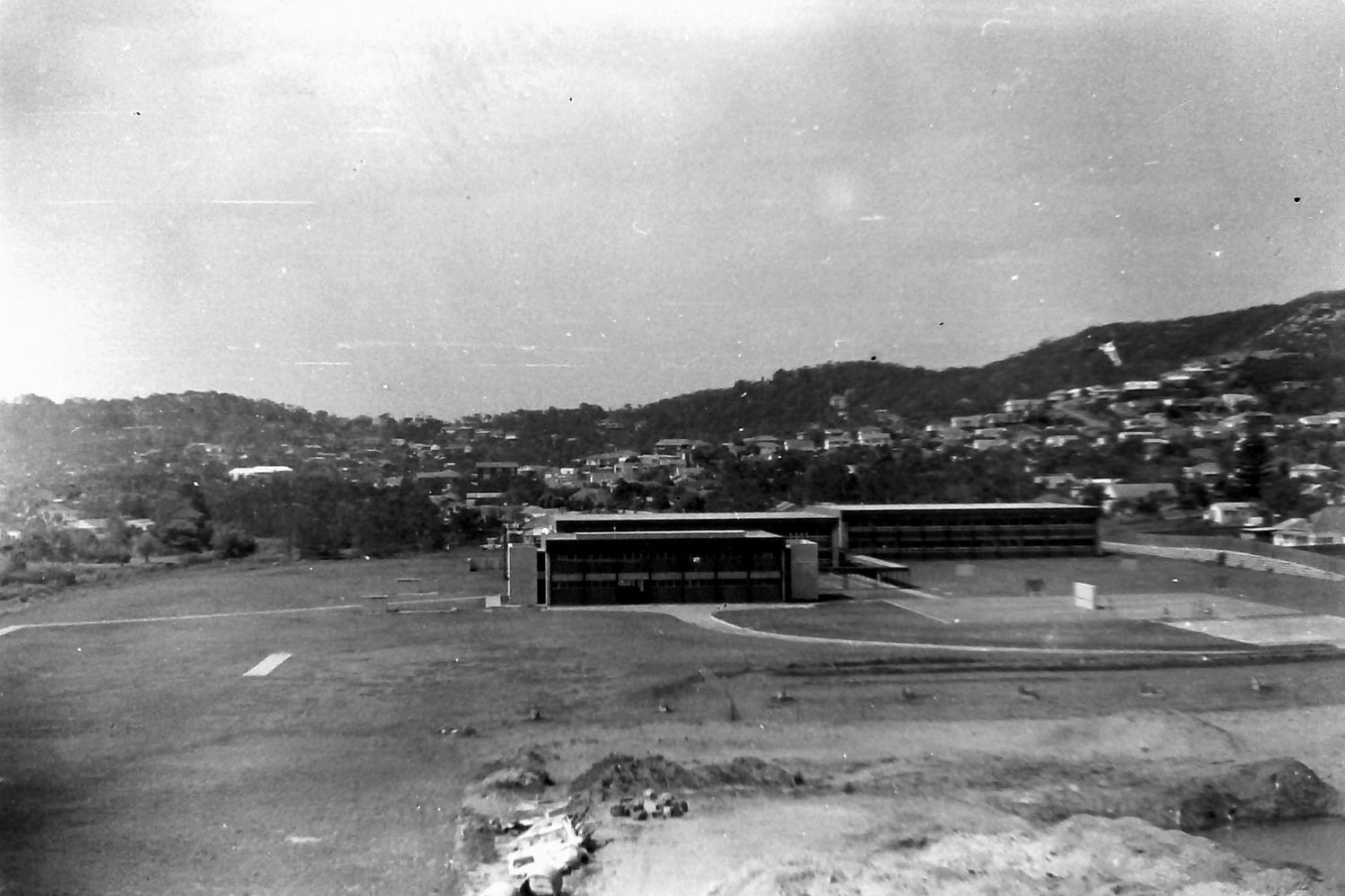
1968 Barrenjoey High School, looking southwest.
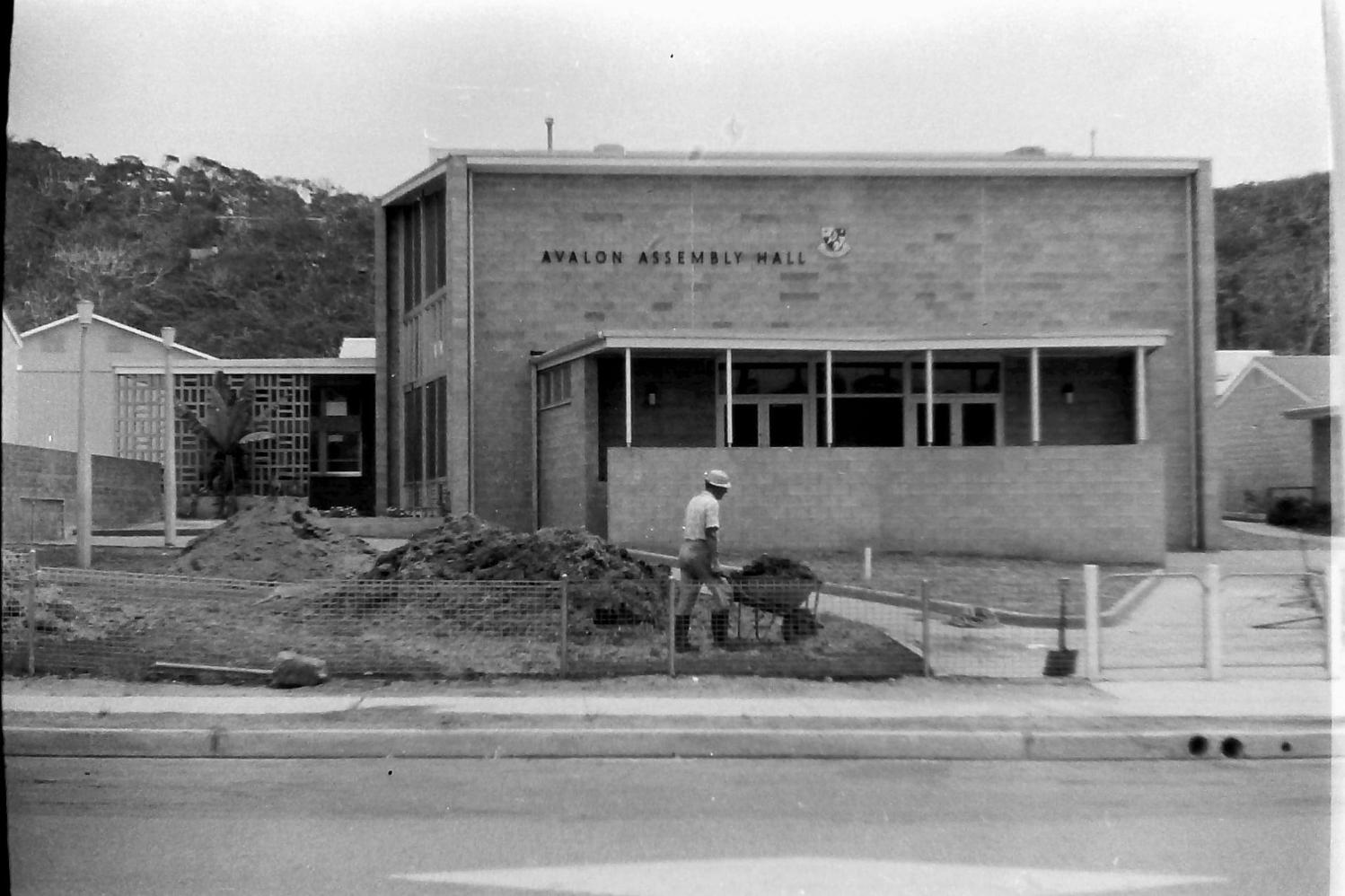
1968 Avalon PS Assembly Hall in 1968 Photos courtesy Gary Clist
.jpg?timestamp=1664659908834)
More in:
- Photos Of Avalon Beach and Surrounds From 1968 And 1970 - Taken By Gary Clist
- Avalon Beach In 1970-71 - More Great Photos By Gary Clist
- Barrenjoey High School Across The Decades Staff Meeting by Sue Martin, December 2018, Issue 387
- Barrenjoey High School's 50th Year Celebrations: The Golden Ball Celebration, The Barrenjoey School of 1872 To 1894 - September 2018, Issue 376
- Carolyn Tucker (Nee Gee) - Barrenjoey High School 50th year 2018 Profiles, Issue 379
- Adam Crowley, son of Carolyn Tucker (Nee Gee) - Barrenjoey High School 50th year 2018 Profiles, Issue 376
- The Barrenjoey High School Winter Night Market: A 50th Anniversary Celebration - June 2018, Issue 364
L to R: Carolyn Tucker (nee Gee), mum of Adam Crowley and sister/aunt Debbie McGregor (nee Gee). On their way to attending the Barrenjoey High School 50 Years Birthday Golden Ball Dinner at the current high school in 2018
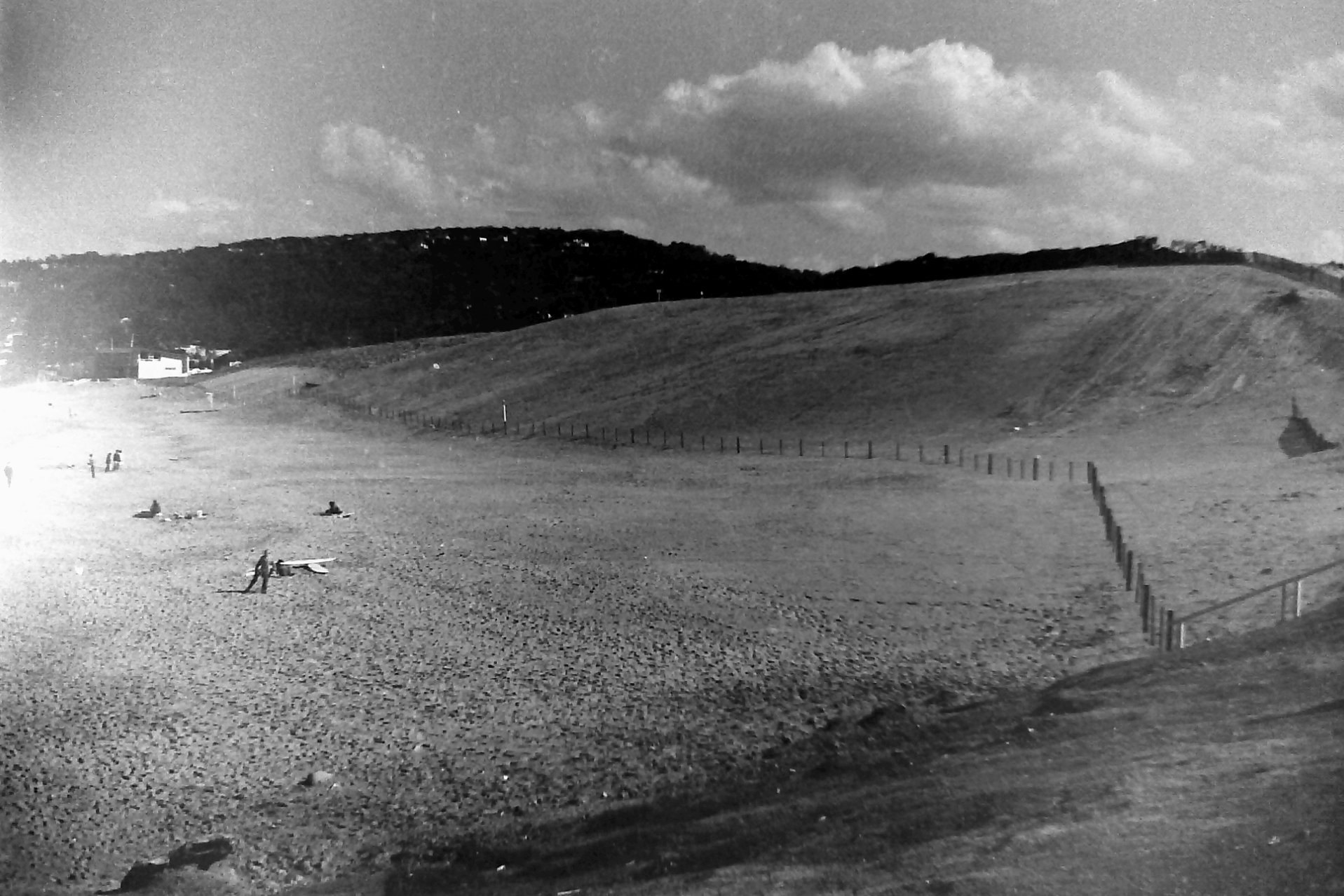
Avalon sandhills pre re-vegetation, 1970. Below: reclaiming the dunes. See; Avalon Beach Sand Dunes: Some History
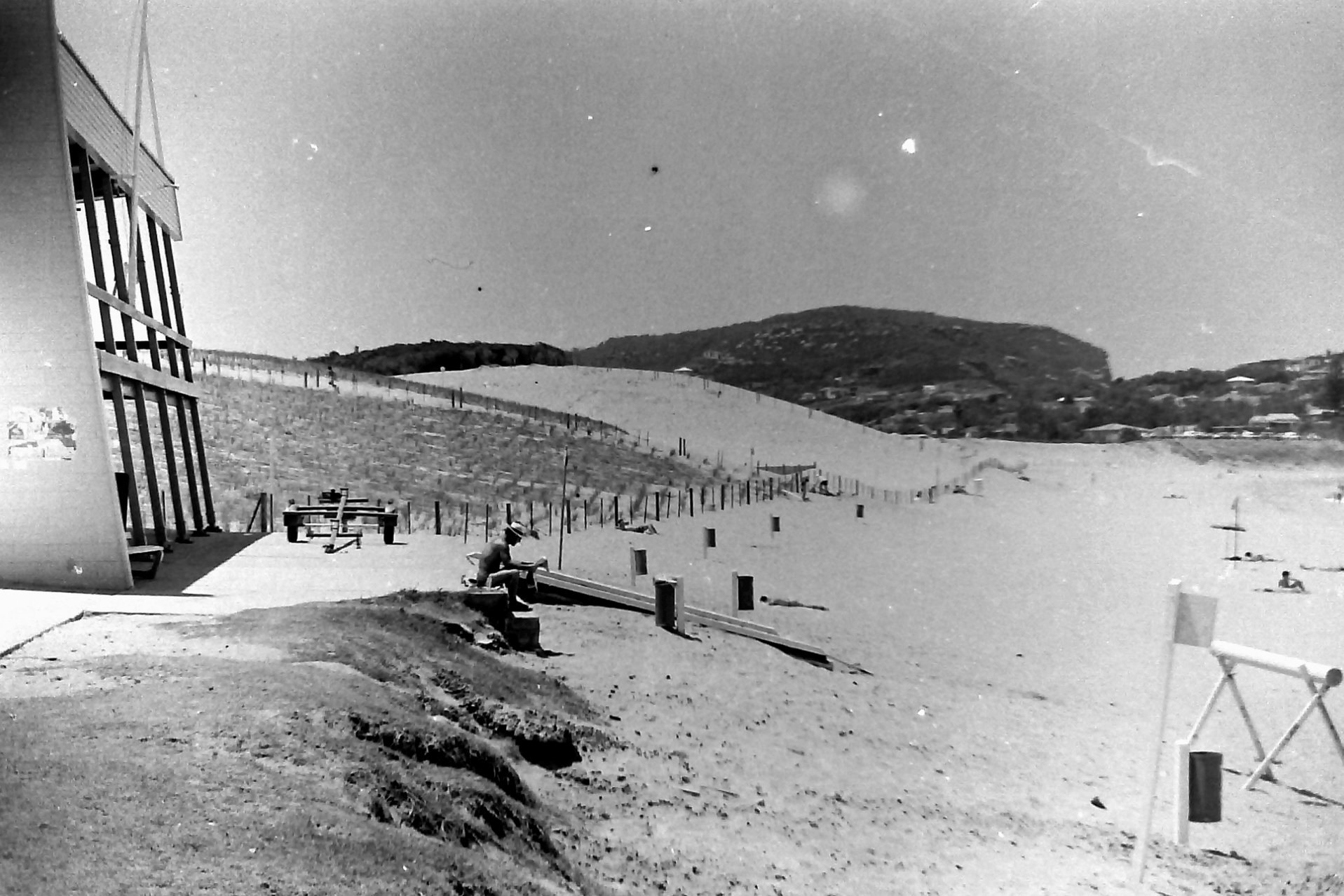
.jpg?timestamp=1664661232185)